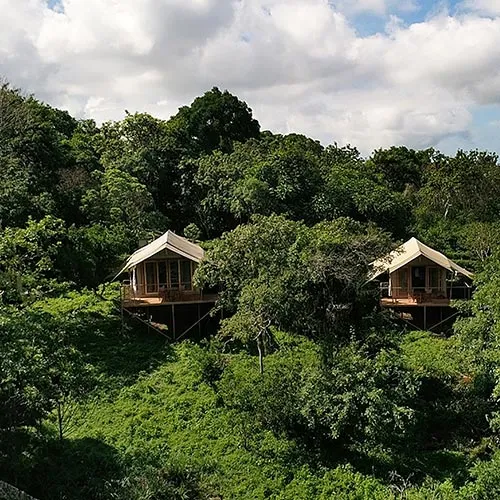Roughly every seven years since the last Ice Age, the Galapagos Islands experience the warm weather phenomenon called ‘El Niño’, a natural event laden with surprises and setbacks for its inhabitants. It affects wind direction, sea currents and storm patterns transforming it into the epitome of Darwinian evolution and reaction to change.
One species of Galapagos marine iguana literally shrinks its bones during El Niño, as food supply dwindles due to warm waters replacing the normally cool Humboldt Current. As ‘El Niño’ dissipates the iguana returns to its normal size.
If you embark on early morning hikes to see the iguanas, tortoises and birds of Galapagos, you´ll witness the effects of El Niño first hand.
Snorkeling, swimming and surfing in the unusually warm currents rewards you with sea lions, penguins and schools of fish, while your land hikes give you a first hand view of the birds, flora and fauna of these Enchanted Islands.
Let´s take a look at different Galapagos activities and what you could expect to see when doing each one:
Snorkeling
- Tortuga Bay on Santa Cruz Island is a 30 – 45 minute hike on a stone trail and leads to one of the most striking white sand beaches you´ll find on the Islands. You´ll see Galapagos sharks and small octopus swimming near the reef that protects part of the beach. Sand swept up from the current sometimes makes the waters murky and the underwater creatures harder to spot.
- Lobos Islet is another popular site for snorkeling on Santa Cruz. Cut off from the ocean except for a small inlet, the protected cove off the western side of the island is a favorite playground for sea lions.
- Galapagos Safari Camp organizes snorkeling day tours to different islands including Bartolome and Santa Fe. On the Santa Fe trip, snorkelers may see reef fish, sea lions, reef sharks, rays and possibly sea turtles.
- Bartolome Island’s Pinnacle Rock attracts snorkelers from the crescent, white and pink sand beach to the east of the pinnacle. The beach is a nesting site for green sea turtles, normally spotted swimming underneath the ‘rock’. Galapagos penguins also frequent the area and hobble along the volcanic ledges of the obelisk amidst sleeping sea lions.
Kayaking
- Kayaking along the Itabaca Channel is an easy way to spend part of the day in search of local wildlife. Located between Santa Cruz and Baltra Islands, the calm waters of the channel are offset by blue-footed boobies, herons, pelicans, sea lions, reef sharks and sea turtles. Garrapatero beach also offers the opportunity to kayak and explore its mangrove shores
Surfing
- Galapagos Safari Camp works with a local surfing school whose mission is to help young surfers become instructors for future visitors. The instructors take those interested to Tortuga Bay, where the waters fill with marine life and few local surfers in search of the perfect wave.
Hiking
- On the island of Santa Cruz, you´ll find trails for experienced hikers to explore the higher grounds of the island. The Cerro Puntudo/Cerro Media Luna trail begins in Bellavista, located 7 km inland from Puerto Ayora. Halfway up the muddy trail is Media Luna, a partial crater home for the main Galapagos petrel nesting colonies. The endangered seabird nests on the ground, and often falls prey to predators in search of hatchlings and eggs. Further up the trail is Cerro Puntudo, a splatter-type volcanic cone that is the highest vantage point on the island.
- Another great hike is on Isabela Island. Depending on which trail you take, the scenic hike to the Sierra Negra volcano takes between two and five hours.
Darwin’s seed eating finches have increased in population during past ‘El Niños.’ The six species of ground finches have historically thrived due to the fertile vegetation and corresponding abundance of seeds.
Charles Darwin Research Station and the Fausto Llerena Tortoise Center
- Visiting the Charles Darwin Research Station in Puerto Ayora on Santa Cruz Island provides insight about the climate, flora and fauna of the islands. The Charles Darwin Foundation and the Galapagos National Park run the adjacent Fausto Llerena Tortoise Center. Visitors observe the Giant Galapagos Tortoises in stages of growth including hatchlings, juveniles, and full-grown individuals. The latter weighs up to 500 pounds and reaches 6 feet in length.
- The breeding center has another program for revitalizing the Galapagos’ Land Iguana population, and you´ll observe the resilient creatures up close, away from the danger of predators.
Land iguanas during the 1982-83 ‘El Niño’ thrived because their food source, cactus pads, flourished. The iguanas can’t climb and normally would have to compete with other creatures for the fallen pads, but the rapid growth of the cactus produced enough food for the reptiles to grow robust.
‘El Niño’ brings more rainfall with its warmer waters, the land becomes lush so the animals flourish. Include rain gear, decent insect repellent and light weight travel clothes in your packing list to protect limbs from bugs during the twilight hours.
Although the duration and severity of ‘El Niño’ is a hard science to master, National Geographic, the Japan Meteorological Agency, the U.S. National Oceanic and Atmospheric Administration and Australia’s Bureau of Meteorology reported that this year’s event will be a strong one, lasting into the winter months but currently waning and expected to return to normal conditions by the North American summer.
‘The natural history of this archipelago is very remarkable: it seems to be a little world within itself.’-Charles Darwin
Questions? Contact Galapagos Safari Camp for information about a unique adventure during ‘El Niño’ in the Galapagos and we will return your message promptly.
